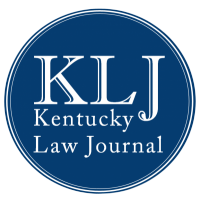Home

Welcome to the Kentucky Law Journal webpage. KLJ is the tenth oldest continually-published law review in the nation.
Kentucky Law Journal Volume 113

Online Originals
Blogs
Student-Written Blog Posts
With conference realignment, the expansion of the College Football Playoff, and the introduction of Name, Image, and Likeness deals for students, the only constant over the past few years in the NCAA has been change. This trend continues with the recent House v. NCAA settlement agreement which effectively takes player compensation a step further by allowing Division I schools to share up to 22% of their athletic revenue with student-athletes. KLJ Vol. 113 Staff Editor Matthew Givens predicts the effects of the new settlement on collegiate athletics and explores ways for the mid-major Division I conferences to keep up in these changing times.
While most states mandate some form of age-appropriate sex education in schools, very few mandate adequate teaching on menstruation, and even fewer incorporate education on managing or dealing with abnormalities in menstruation. Awareness of serious conditions like Endometriosis highlight the need for sex education in schools, yet the need must be balanced against the parents’ rights to opt-out of sex education training. KLJ Vol. 113 Staff Editor Leigha Whitridge advocates for nationwide reform in the area of menstruation education and looks to the country’s capital for inspiration on how to institute such change.
While the guarantee of an impartial jury remains a touchstone of the American justice system, the endless information at any juror’s fingertips presents an attack on this guarantee. High profile cases present more problems than ever as access to social media makes keeping juries impartial a tall task. KLJ Vol. 113 Staff Editor Preston Goodman explores remedies to jury impartiality problems in the modern era.
Twelve cents an hour. Seems a near laughable number of cents, but twelve cents an hour is what inmates within the United States Federal Prison System are earning. Prisoners struggle not only with low wages but also affording basic necessities at the commissary where prices are marked up sometimes five times what they would be outside the prison walls. KLJ Vol. 113 Staff Editor Hannah Carroll explains how paying inmates mere cents an hour combined with exorbitant prices for basic necessities has resulted in a violation of the United States Constitution’s Eight Amendment’s Cruel and Unusual Punishment Clause.
While generally car buyers who take out a loan on their vehicle leave dealership lots satisfied, many of these borrowers, upsold into a vehicle they may not be able to afford, discover “negative equity” and its implications. Borrowers rarely comprehend the gravity of possessing negative equity until faced with its debilitating consequences. KLJ Vol. 113 Staff Editor John Simms explores the current realities borrowers with negative equity face and cleverly proposes using an existing consumer protection statute to curb the massive amounts of negative equity in the automotive market.
In the year 2025, data is currency, and for the convenience of participating in the digital market, most Americans are willing to pay. Yet, with new technologies like the quantum computer on the horizon, the safety of Americans’ data is in jeopardy as the quantum computer could decrypt what would take the classical computer billions of years to work through in mere hours. KLJ Vol. 113 Staff Editor Bridget Lienau explores the future of cryptography and advocates for more comprehensive federal data privacy framework to unite American consumers, businesses, and government at all levels in minimizing the data which can be stolen and mitigating the harms of that which already has.







